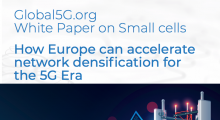5G-MEDIA: Ultra High Definition over Content Delivery Network

5G Context
Content distribution relies on underlying network capabilities and a reliable, high-quality content-aware network. Networks with open standards, interfaces and protocols can unleash the potential for everyone to access all areas of the Internet, opening up opportunitie for operators, manufacturers and content providers to become part of the value chain without having to depend on legacy CDNs.
Enhancing the open CDN concept using a flexible network architecture with new capabilities helps developers provide apps for 5G networks to distribute UHD content (4K and 8K) with the minimal consumption of resources. A new NFV architecture (network function virtualisation) can accommodate flexible resources and dynamically allocate computing resources and cloud-distributed functionalities.
Advantages of 5G technologies and capabilities over exising solutions include: Making content available without delay or jitter and consuming fewer resources. Using micro-cloud at the edge can dynamically instantiate network applications closer to users without needing replica servers and pre-fetched allocations. Using a cognitive network optimiser reduces the overhead of media delivery and reduces latency. Using a mix of edge and central computational resources required by supply and demand patterns can allow dynamic balancing and caching.
5G-MEDIA Advances
5G-MEDIA (Programmable edge-to-cloud virtualised fabric for the 5G media industry) has implemented an integrated 5G media platform that has been extensively tested against its three use cases, including tele-immersive applications. Key innovations for the media industry include:
- A complete service development kit (SDK).
- 5G service catalogue with AAA mechanisms for media service management, accounting and billing.
- Multi-hierarchical cognitive network optimiser for continuous enhancements during and after service deployment.
- Enablement of traditional and serverless orchestration allowing event-driven orchestration of services at run time.
5G-MEDIA Demo
5G-MEDIA has tested and validated its platform capabilities to flexibly deploy and optimise media service applications.
Enabling media service providers (MSPs) to build flexible and adaptable media distribution service chains comprising virtualised functions.
Delivering ultra-high definition media content with users moving around in geographically distributed 5G networks.
The demo on UHD over Content Delivery Network (CDN) shows the integration and use of 5G-MEDIA components for optimising the development and deployment of the media service.
The 5G-MEDIA SDK and the 5G Apps and Services Catalogue are used for the design, dimensioning, creation and onboarding of the media service components, such as the VNFs building the vCDN service, both in the form of regular VM-based and serverless media functions.
The 5G-MEDIA SVP is used for the instantiation and application configuration of UHD media delivery services such as NFV Network Services.
Here, the coordinated configuration of the media caches and load balancing functions is applied by the 5G-MEDIA SVP to re-direct users to proper media content delivering caches (e.g. based on load).
The 5G-MEDIA MAPE module monitors the running media content delivery services, predicts any performance degradation (at both network and media service level) using specific online ML algorithms in the SS-CNO, automatically adapting and optimising the media service by dynamically scaling the media caches hierarchy (with the option of creating either regular VM-based or serverless virtualìsed caches). Properly reconfiguring the load balancing function for maintaining UHD streams user perceived quality in case of network congestion.
In terms of ITU 5G functionalities, 5G-MEDIA has investigated:
- Enhanced Mobile Broadband (eMBB).
- Ultra reliable low latency communications (URLLC).
It has also investigated:
- QoE monitoring: end-to-end quality control.
- Caching policies: balancing bandwidth vs. caching, establishing the policies.
- Service orchestrator: management of the service chaining to build the CDN delivery.
- Cognitive Network Optimiser: optimising network resources.
- Edge computing related functionalities: getting closer to the user will improve service level. DPI: to understand content nature (audio, video, streaming type).
Locations: Pisa, Rome (Italy); Madrid (Spain)
Dates: Q4-2018; Q2-2019; Q4-2019
Showcases: Demo at MWC2019. Mobile World Congress 2019 at the stand of the 5G Infrastucture Association (5G-IA). EuCNC2019. 5G Day (8th OSM Hackfest): “From Data-centers to the Edge with OSM”. IBC2019 event.
Industry Vertical Partners: RTVE
Partners involved: Nextworks s.r.l., OTE, Telefonica R&I, Singular Logic, University College London, IRT, Madrid University of Technology



